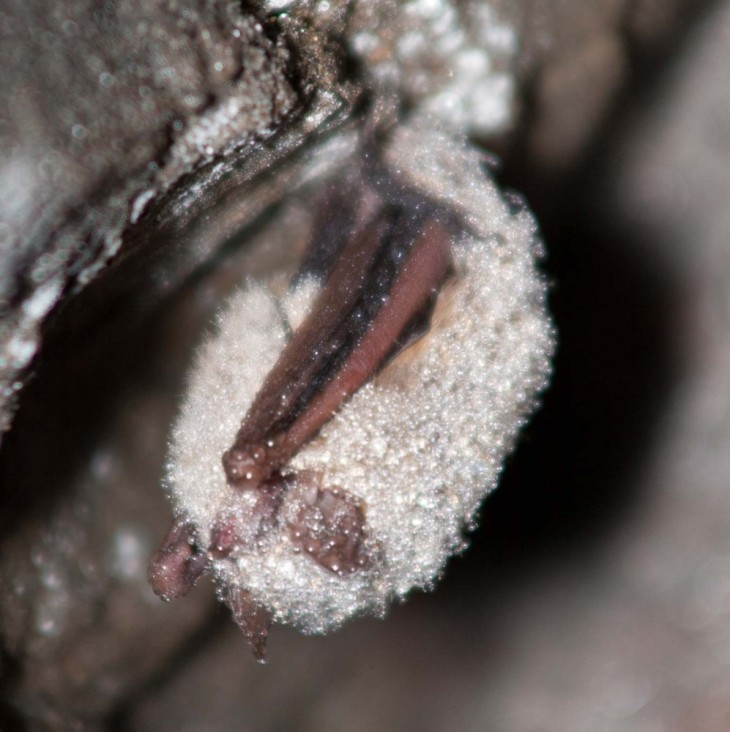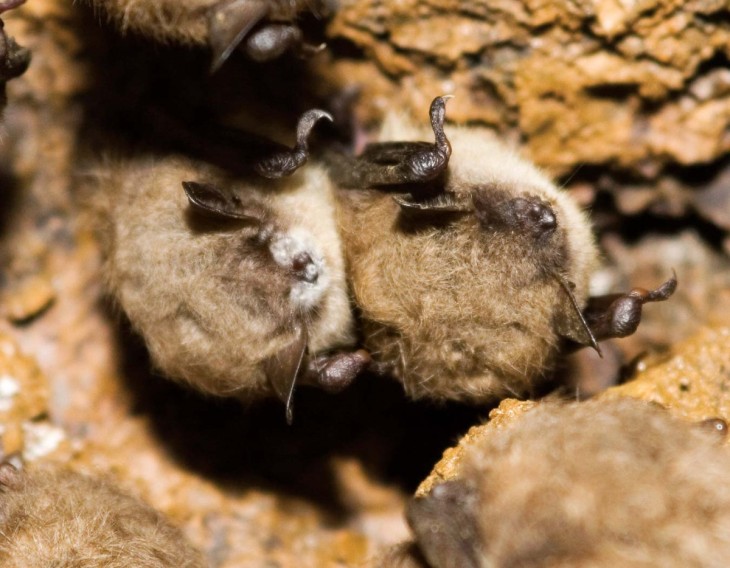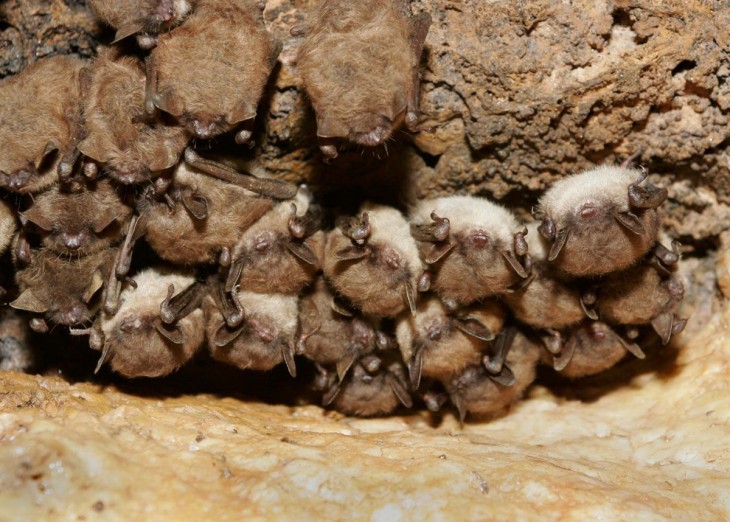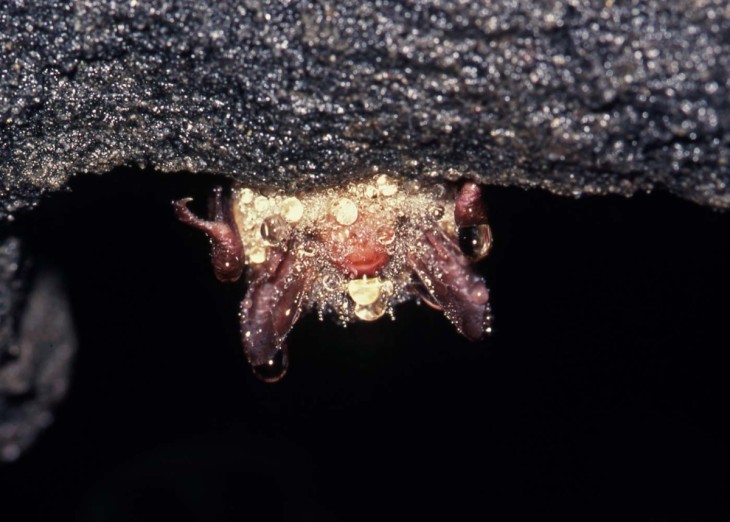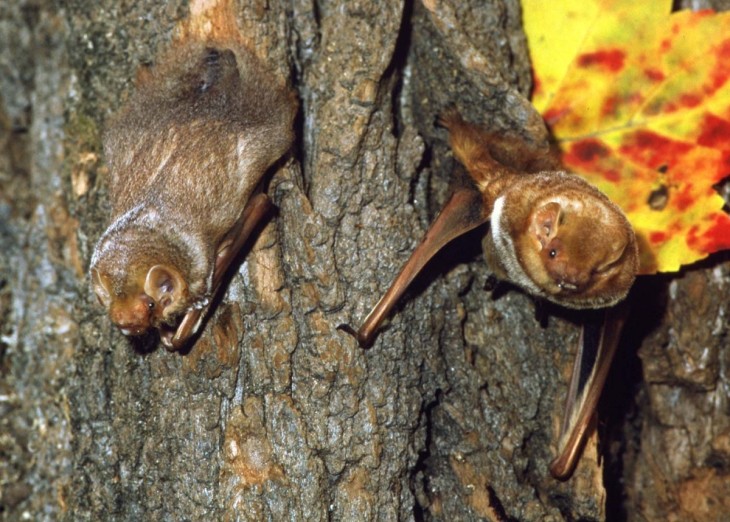
The social nature of cave bats and their penchant for cold, humid wintering roosts make them particularly vulnerable to white-nosed syndrome (WNS), a disease caused by the Pseudogymnoascus destructans (Pd) fungus. The Pd fungus thrives in dark, cold, damp environments and infects cave bats during hibernation, when their metabolism and immune systems are suppressed. WNS is visible on infected bats as a white growth on their muzzle and skin; it causes them to awaken more frequently, which leads to the burn-off of indispensable fat reserves. Infected bats seeking to replenish these reserves in winter will die from exposure and starvation.
Discovered in an Albany, New York, cave in 2006, WNS has decimated bat populations in the United States. Researchers across the eastern and midwestern states have scrambled to understand the Pd fungus – which spreads easily from bat to bat – and to slow the spread of WNS.
In Connecticut, all but one of the six cave bat species are on the state lists of special concern, threatened, and endangered. Connecticut had a bat monitoring program before the discovery of WNS in the state in 2007. In the early 1990s, the state standardized previously sporadic winter colony counts, and by the early 2000s, all nine Connecticut bat species were included in the annual counts, although the method of garnering information changed. In the northwest corner of Connecticut, monitoring shows that the populations of little brown bat, northern long-eared bat, and tricolored bat fell drastically soon after WNS was discovered here (see chart).
“Prior to WNS, there were capture efforts to collect demographic data across the state, as well as telemetry studies to determine roosting preferences in order to restore critical habitat,” said Devaughn Fraser, the lead bat biologist at Connecticut’s Department of Energy and Environmental Protection (DEEP). “Since WNS, however, we’ve refrained from active capture studies to limit spread of the pathogen.”
Protecting hibernacula is crucial. People visiting caves during the winter can disturb hibernating bats, which makes them burn precious energy reserves and can lead to starvation. The risk is greater when bats are infected with WNS. With populations in peril, the state is now welding gates across cave and abandoned mine entrances; these gates block human entry but allow bat passage.
Both technology and volunteers have been crucial to recent bat conservation. Bill Reid, chief ranger of eastern Connecticut’s The Last Green Valley – a 35-town National Heritage Corridor – is one of 12 volunteers who drive bat-monitoring routes across the state all summer. Under Fraser’s guidance, Reid uses a laptop and microphone to detect the different echolocation calls of each species.
“I do two surveys a month,” Reid said. “One from Windham to Putnam and then the same route in reverse. This summer was tough with so much rain and some nights too cold [for optimal bat activity]. The data from each night is saved on the laptop and at the end of the season they retrieve the equipment, download the data, and return everything [to me] the following spring.”
Work by Reid and other volunteers allows state wildlife officials to monitor summer bat populations – both cave and tree – to determine recruitment success, movements, and how populations are faring going into winter. The acoustic transects also help biologists pinpoint which bat species favor which habitats to hone management priorities. Fraser also teaches volunteers how to count bats at maternity colonies and plans to implement other monitoring tools.
Better understanding of the genetics of distinct bat populations in different regions and hibernacula might eventually play a role in bat management, as well, and Fraser is compiling a bat genetic archive toward that end. For the acoustic data, she sees more immediate gains. Close analysis will show which species favor which habitats, allowing biologists to tailor management plans for each of Connecticut’s nine bat species.
Stemming WNS’ effects is vital to bats’ survival. Bats are an evolutionary marvel, and Fraser’s work and similar efforts in other states will be critical to restoring them to healthy numbers.
